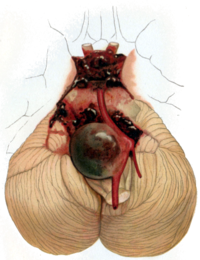
Photo from wikipedia
OBJECTIVE To study the clinical and morphologic characteristics associated with risk factors for the rupture of intracranial aneurysms (IAs). METHODS A total of 1115 consecutive patients with 1282 IAs were… Click to show full abstract
OBJECTIVE To study the clinical and morphologic characteristics associated with risk factors for the rupture of intracranial aneurysms (IAs). METHODS A total of 1115 consecutive patients with 1282 IAs were reviewed from August 2011 to February 2016. The patients and IAs were divided into ruptured and unruptured groups. Based on the clinical and morphologic findings, the risk factors for IA rupture were assessed using statistical methods. RESULTS Age, hypertension, diabetes mellitus, and cerebral atherosclerosis were associated with ruptured IAs. IAs located in the anterior cerebral artery, the anterior communicating artery, the posterior communicating artery, and the internal carotid artery were associated with ruptured IAs. Ruptures were also associated with arterial bifurcations, irregular aneurysm shapes, and all continuous data, except neck width. Binary logistic regression showed that IAs located at bifurcations (odds ratio [OR], 1.804), with irregular shapes (OR, 4.677), with high aspect ratios (ARs) (OR, 5.037) or with small mean diameters (MDs) (OR, 0.495) are more prone to rupture. Receiver operating characteristic analysis showed that the threshold values of the AR and MD were 1 and 3.70 mm, respectively. CONCLUSIONS Morphologic characteristics, such as being located at bifurcations, being irregularly shaped, having a high AR (>1), and having a small MD (<3.70 mm), were better predictors of rupture.
Journal Title: World neurosurgery
Year Published: 2018
Link to full text (if available)
Share on Social Media: Sign Up to like & get
recommendations!